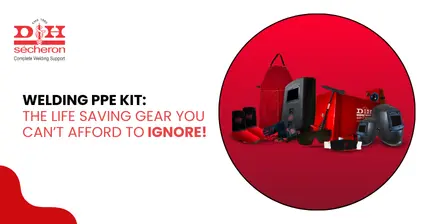Wear and tear in any heavy machinery or application is a common. Wear can be chemical or mechanical, depending on various factors.
The wear factors are categorized into two types – Primary and Secondary. These are further sub-classified into different factors. Let’s understand.
Primary Wear Factors
Abrasion
Friction
Impact
These factors are responsible for higher loss of wear or material as compared to the secondary wear factors.
Secondary Wear Factors
Erosion
Corrosion
Heat
Cavitation
These factors do not cause wear and tear as much as the primary factors. However, they still need to be taken into consideration to arrive at a holistic solution. The reason is that there is hardly any application in any industry which is prone to only one type of wear.
How Hardfacing Electrodes Can Help?
Hardfacing welding electrodes are specially designed for surfacing applications that are highly vulnerable to primary and secondary wear. They are also designed to protect parts that are subjected to severe abrasion.
However, it is important to understand that simple hardness in an application doesn’t give assurance of the longer life of a component. It should have the right amount of Low Alloy to give a longer life as well as tackle the wear areas. This means that a combination of hardness and alloy is necessary to get effective results.
Hardfacing electrodes find their applications in Thermal Power Plant, Steel plant, Mines, Cement plant mines and other mining areas to repair the hardfacing material of handling buckets in porcelain machines and wheel loaders. In general, depending on the type of material ore such as coal, limestone or iron ore, the typical wear factors in the application are high abrasion that is caused by non-metallic particles on metal combined with impact. Hence, it is safe to assume that simple high iron carbide deposits that have 60 HRC hardness are likely to have a longer life.
However, this is not enough. You also need to consider the application/service condition on-site, closely look at the topography and other climatic or geographical conditions under which it is working.
If you are looking for a wide range of welding electrodes and alloys to tackle the wear factors, D&H Sécheron can meet all your requirements.
11 May 2025 | Welding
An In-Depth Exploration of Low-Alloy Steel: Your Comprehensive Guide
11 May 2025 | Welding
Nagpur - Bori - Tuljapur Road MSH-3 in Yavatmal District (Maharashtra)
11 May 2025 | Welding
Guidelines to Understand Gas Welding: Applications, Advantages & Disadvantages
11 May 2025 | Welding
3 Tips for Finding the Best Mild Steel Electrode for Your Application
11 May 2025 | Welding
How to Select the Right Welding Filler Wires for Stainless Steel Welding?
11 May 2025 | Welding
Building the Narendra Modi Stadium with Norma V and Autotherme-1 Electrodes
11 May 2025 | Welding
Low Alloy Steel Welding in a (PEB) Pre Engineered Building Structure
11 May 2025 | Welding
Welding Rods: Different Types and Tips for Properly Storing and Handling
11 May 2025 | Welding
Tips for Flawless Welds with Stainless Steel Electrodes: Pros and Cons
11 May 2025 | Welding
Exploring Applications and Benefits of Stainless Steel Welding Electrodes
11 May 2025 | Welding
Welding Basics: Joining Metals with Heat and Pressure - A Beginners Guide
11 May 2025 | Welding
Distinguishing Low-Alloy Steel from High-Alloy Steel: Understanding the Variations
11 May 2025 | Welding
Hard Facing Wire - Understanding the Process and Achieving Optimal Result
11 May 2025 | Welding
Exploring the Advantages of Stainless Steel Electrodes in Welding Applications
11 May 2025 | Welding
Weathering Steel vs. Traditional Steel: A Comparative Analysis of Performance
11 May 2025 | Welding
Choosing the Right Welding Rod: Why 6013 Electrodes Might Be Your Ideal Option
11 May 2025 | Welding
Why 7018 Electrodes Are Preferred for High-Strength Welds in Pipeline Construction
11 May 2025 | Welding
Filler Wire vs. Stainless Steel Filler Wire: Understanding the Key Differences
11 May 2025 | Welding
Exploring the Impact of Filler Material on Welding Quality and Durability
11 May 2025 | Welding
Choosing the Right Cast Iron Electrode for Different Welding Projects
11 May 2025 | Welding
Top Advantages of Cast Iron Electrodes for Industrial Welding Applications
11 May 2025 | Welding
Key Benefits and Challenges of Using TIG Welding in Industrial Projects
11 May 2025 | Welding
5 Reasons Why 7018 Electrode is the Gold Standard for Welding Professionals
11 May 2025 | Welding
Top 5 Advantages of Flux Cored Arc Welding for Heavy-Duty Applications.png)
11 May 2025 | Welding
Lotherme-601: A Game-Changer for Restoring Shoulder Pins in Heavy Machinery
11 May 2025 | Welding
How D&H Sécheron Helped Repair a Rotary Kiln’s Cooler Section with LoTherme 352
11 May 2025 | Welding
Piston Repair for Mining Industry: Cost-Effective Solutions with LoTherme 468.webp)






.jpg)







































.jpg)
.jpg)

.jpg)

.jpg)





.jpg)
.jpg)
.jpg)



.webp)
.jpg)
.jpg)
.webp)
.jpg)






















.png)



.webp)

.webp)
.webp)



